Arashiyama 1 Day Itinerary: Plan Your Day Trip from Kyoto

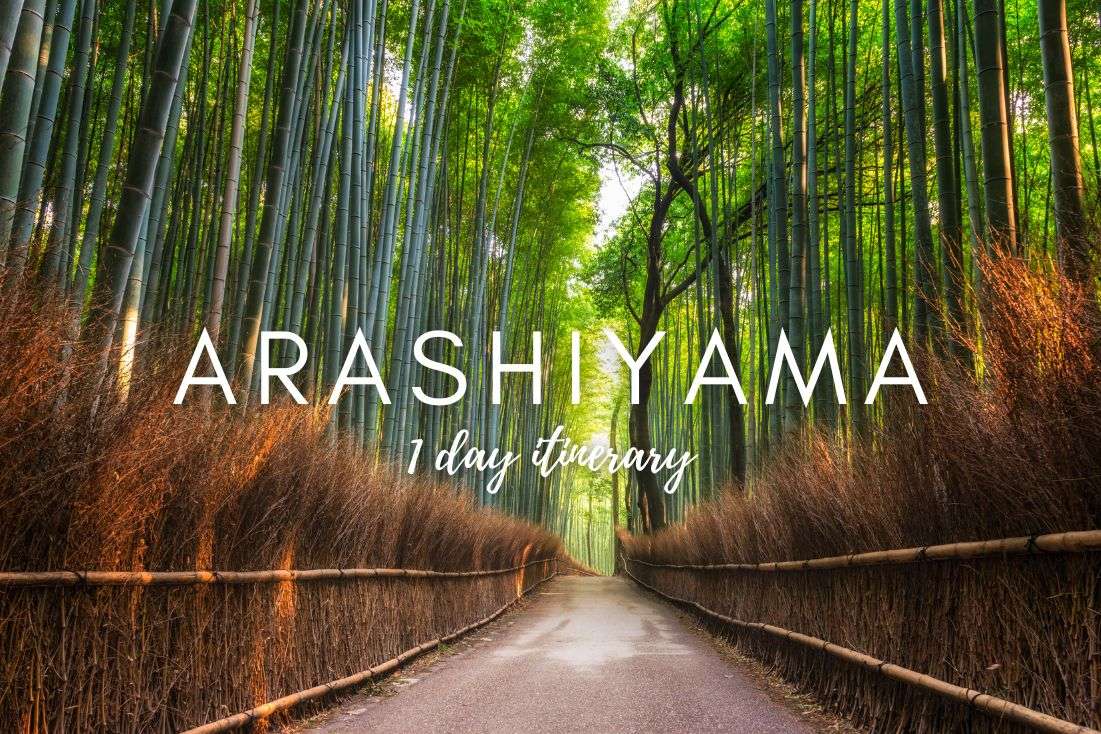
Arashiyama Itinerary, stop 1: Arashiyama Bamboo Forest
Arashiyama Itinerary, stop 2: Sagano Romantic Train
Arashiyama Itinerary, stop 3: Tenryuji
Arashiyama Itinerary, stop 4: River walk and Arashiyama Park
Arashiyama Itinerary, stop 5: Jōjakkōji
Arashiyama Itinerary, stop 6: Ninna-ji and Ryōan-ji
Arashiyama Itinerary, stop 7: Kinkakuji
How to get to Arashiyama Station from Kyoto Station?
How long does it take to walk through the Arashiyama bamboo walk?
Arashiyama is famous for its bamboo forest and scenic train route, but is there anything else to do there to warrant a full-day visit? I guess the title of this article is giving it away, so no surprise there: Yes!
The Arashiyama area is perfect for a one-day trip from anywhere in the Kyoto-Osaka monster mega city (though you’ll find out soon enough that part of that full day isn’t really in Arashiyama District, so even a half day will do it).
To be clear, Arashiyama is inside Kyoto, and though it’s at the very northwestern edge of it, you’re never leaving the city when you go there. But I suspect you’ve looked at a map and know that already.
More articles about Japan can be found in a dedicated section.
In this article, I’ll try to arm you with all of the Arashiyama info you could ever want:
- Most importantly, a full Arashiyama itinerary for 1 day. It has all the details you need; you basically need to just rock up and follow along.
- Then, a small FAQs section about how long to spend in Arashiyama, the things you can do there, train details, and visitor information for the bamboo forest.
To start out, let’s look at the top places you’ll be visiting in Arashiyama:
- Arashiyama Bamboo Forest: a 20-minute walk through Arashiyama's main claim to fame, the bamboo forest
- Sagano Romantic Train: a scenic ride on an old wooden train through the picturesque ravine
- Tenryuji: Visit the most important Zen temple in Kyoto
- River walk and Arashiyama Park: take a walk up and around the hill that’s at one end of the bamboo forest walk, and along the Katsura River
- Jōjakkōji: a peaceful temple with magical, mossy paths, in the forest, overlooking the city
- Ninna-ji, Ryōan-ji, and Kinkakuji: think sand gardens, rock gardens, and a golden temple on a lake a bit outside of Arashiyama
Here’s the itinerary I put together based on my experience in Arashiyama. It will keep you busy for a full day, or just a half day if you don’t count (or don’t visit) the last three temples (I warn you, though, you may regret it!):
Arashiyama Itinerary, stop 1: Arashiyama Bamboo Forest

The famous Bamboo Forest in Arashiyama
Time spent at this stop: 20 minutes
The highlight of Arashiyama and the main reason everyone visits the village of Sagano is the Bamboo Grove. Given its Insta fame and crowdedness (just you wait and see!), you may be surprised that it’s just a 500 m (0.3 mi) long walk.
Depending on how long you take trying to get your photos at just the right angle, expect to be done in 20 to maybe 45 minutes if you are moving at a snail’s pace.
Honestly, I was expecting full-blown bamboo forests, but it isn’t the case.
Tip: Remember that everyone tries to take their pics the moment they spot a bamboo tree, so if the photo crowds are too much, just move on further down the path where it usually calms down.
I was surprised that although it’s just a forest of bamboo trees with a path running down the middle, it’s quite impressive! Those things are massive! I really thought bamboo tree trunks were thinner for some reason…
The bamboo forest is free to enter, and there are no access hours; it’s open 24/7. The earlier you go, the fewer people will be photobombing you. There’s literally one path through the bamboo trees, meaning you can’t walk inside through the forest all willy-nilly, so everyone is condensed to one narrow sidewalk.
Where to enter Arashiyama Bamboo Forest
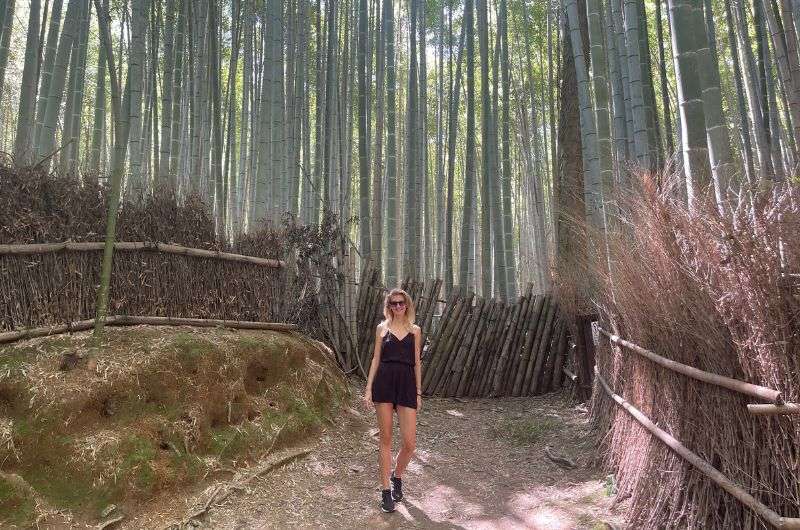
Even with the crowds, you can take a quick snap without them if you’re patient enough
You can enter the Arashiyama Bamboo Forest from either end, either near the Torokko Arashiyama Train Station (which is only a stop on the Sagano Romantic Train but not JR trains, so you can’t get off there when traveling from Kyoto), or from the main street behind Tenryu-ji (temple)—see the map below.
The train from Kyoto Station will drop you off at JR Saga Arashiyama Station, and most parking is along the main road of Sagano, so both of these options predestinate you to enter the Bamboo forest from the eastern end.
It makes sense to buy your Sagano Romantic train tickets either in advance, so you can end your bamboo forest walk at the Torokko Arashiyama Station and then hop on the train there once your time comes.
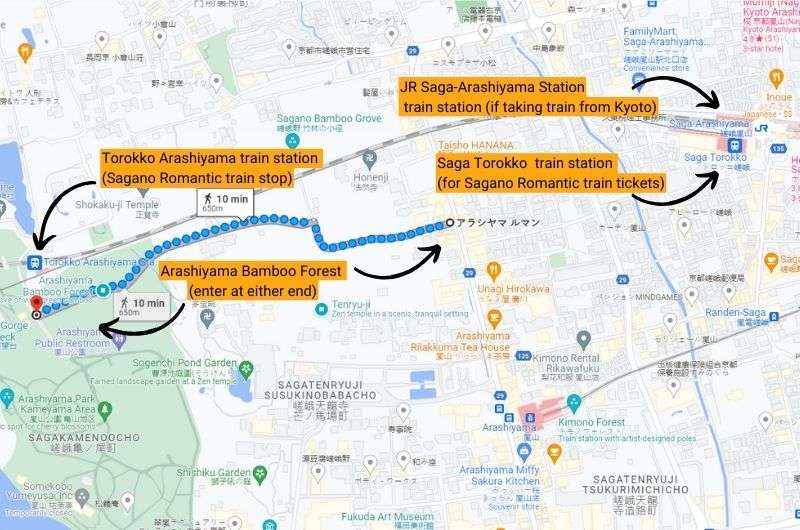
The east entrance to the Arashiyama Bamboo Forest is a 15-minute walk from the Saga Torokko Station/JR Sara Arashiyama Station.
If you drove from Kyoto city center, there are many parking lots around the start of the bamboo forest trail along the main street, so just pay attention to the prices—they increase in peak tourist season. Some are paid by the hour, some have a daily fee (around JPY 1000 per day).
Arashiyama Itinerary, stop 2: Sagano Romantic Train
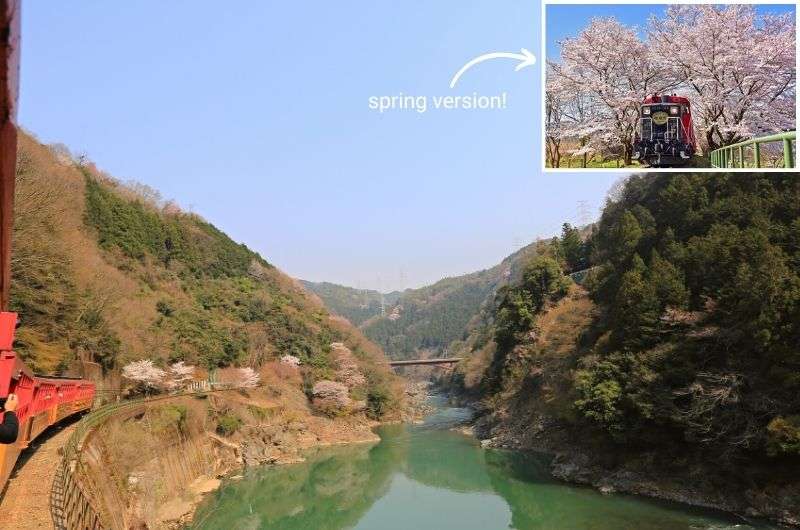
Sagano Romantic Train
Time spent at this stop: 1.5 hours
Next, hop on the “Sagano Romantic Train,” which takes you—slowly but surely— through the nearby ravine, offering half an hour (one way) of picturesque scenery. You’ll take it twice (there and back), so that’s 1 hour of very slow, romantic nature-watching!
Tip: Unless you’re visiting when the weather sucks, try to get tickets for the coveted “rich car”. Car no. 5 is open-air, while all other cars have glass windows. They do open, but it’s not the same as getting the breeze of fresh ravine air guaranteed. Then again, umbrellas are forbidden on the train, so expect to get wet when it rains.
Buying tickets for the Sagano Romantic Train
Like I said, if you’re visiting in peak tourist season, which is basically any time except for winter, you’ll want to get your Sagano Romantic Train tickets in advance (on Klook, at travel agents, or at any JR ticket office), or at least get to the Saga Torokko station there right at 8:30 am when the ticket office opens.
You’ll get a ticket for a specific time, so, depending on how sold out the tickets are by the time you get yours, you may need to switch the stops on your Arashiyama itinerary around a bit to accommodate the time you get (trains start going at around 9 am).
They sell tickets for the seats first, then you can get a few standing tickets, and then the train is sold out, and you’re out of luck.
Make sure to get a return ticket for the train as well, get back to your car, and head out—it’s time to see some temples!
- Tickets: JPY 620 (one way)
- Sagano Romantic Train official website
Arashiyama Itinerary, stop 3: Tenryuji
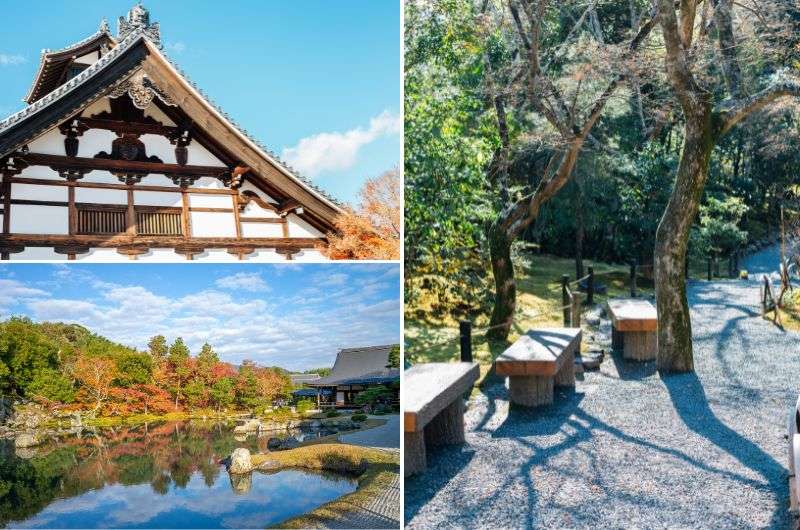
The very, very old and very, very nice Tenryuji temple
Time spent at this stop: 30 minutes
Tenryuji is the most important Zen temple in Kyoto, having been built by the ruling shogun for the former emperor in 1339 after the old emperor had just died. Something about making amends after turning against him in his last years, trying to take over power.
Not gonna lie, I think getting a posthumous present like that—one that probably just made the shogun look good in the public eye—just made the dead emperor angrier.
Unlike the temple‘s gardens, which are very, very old and very, very nice, the buildings all had to be rebuilt several times after burning down in fires and wars and such, so they’re actually pretty new.
The scenery of the Arashiyama mountains doesn’t hurt it either. It’s a very tranquil place, something you’ll need after walking through the tourist masses at the bamboo grove (don’t get me wrong, all the crowds come here, too, they just have more area to spread out).
You can choose from admission to just the gardens or also to some of the buildings. Then there’s the special cloud dragon ceiling painting in the dharma hall, which is another extra fee, but that’s only available on weekends and holidays.
- Tenryuji official website
- Open daily 8:30 am – 5 pm
- Tickets: JPY 500 to just the gardens, JPY 300 extra for the buildings, JPY 500 extra for the dragon painting (only on weekends and holidays)
Arashiyama Itinerary, stop 4: River walk and Arashiyama Park
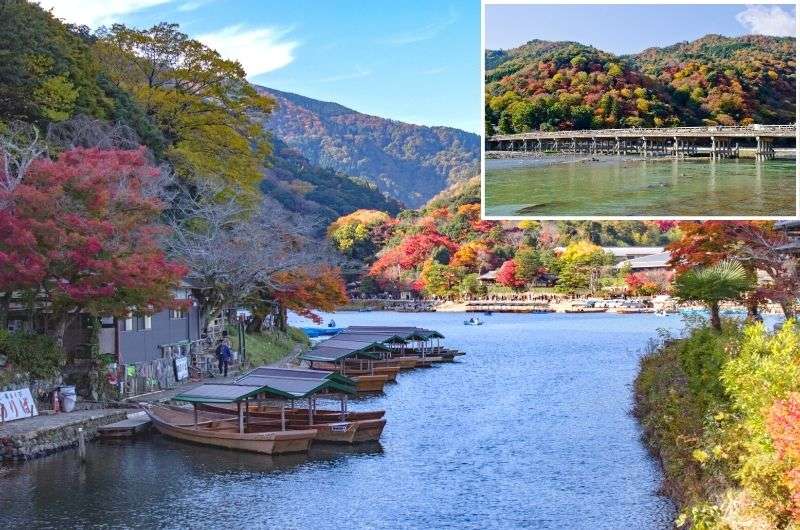
Take a walk along the Katsura River and stop by (or at least notice) the old Togetsukyo Bridge
Time spent at this stop: 1 hour
From the temple, make your way down towards the Katsura River—you’re now ready to explore the beautiful walk along the river and towards the hills and viewpoints of Arashiyama Park. Don’t be tempted to skip this part of the itinerary, because it’s really beautiful. Arashiyama is all about the scenery, so to the scenery we go!
You can take a small detour at the start of the walk to the famed Togetsukyo Bridge, a 155 m (500 ft) wooden bridge that isn’t really all that wooden, but they like to call it that. It’s not spectacular or anything, but you can get nice pics from it.
Then, just walk on the narrow path along the river. You’ll see many small boats taking tourists for a slow trip on the water, and the trees of the hill on the opposite bank will either be nice and colorful or not, based on the season you visit. We went in the summer, so they were just green.

Arashiyama Park
Eventually, you’ll reach stairs that’ll lead up to higher ground and through Arashiyama Park’s many paths. Wow, that “eventually” makes it sound like this is a super long trail! Let me set your expectations straight—the river walk portion is only a 15-minute stroll, tops. Wander around and try to find the 3 observation points, all of which give you similar views, but there are benches to sit on, so they are a nice place to take a breather if you need it. It was a million degrees when we were there, so even though the terrain was very easy, the heat wasn’t!
Upright by the western end of the bamboo forest walk is a Japanese garden with a tea house, which could be an alternative rest stop if you like yours with a chilled matcha (or something else). There’s an entrance fee of JPY 1000, and it’s worth it for the drinks and emptiness alone. As with all Japanese gardens, it’s tranquil and meticulously planned, easy to spend 20 minutes in (even if you’re already over-gardened and just have the tea!).
After the Japanese garden, you’re perfectly situated to move on to the next thing to do in Arashiyama: Jōjakkōji Temple.
Arashiyama Itinerary, stop 5: Jōjakkōji
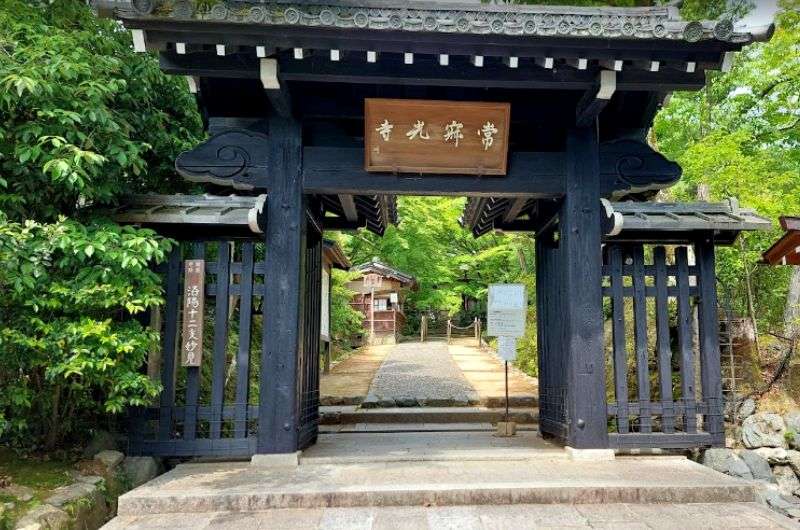
Jōjakkōji temple
Time spent at this stop: 1 hour
This wouldn’t be Japan (and Kyoto, specifically) if there weren’t at least another couple of temples on your Arashiyama day trip itinerary… it’s temple central! Or have you not seen my Kyoto – Osaka – Nara itinerary yet? Yeah, temples are sort of a thing in these parts!
So, first, I recommend walking 10 minutes north from the northern edge of Arashiyama Park along a pleasant path to Jōjakkōji—a temple on the side of Mt. Kokura, in the middle of a forest, with views for days. Nuff said!
Imagine winding paths and old staircases shaded under the trees, moss covering the rocks like a soft blanket, stones and shrubs meticulously placed in just the right spots, and—wait for it—bamboo trees!
The ones at Jōjakkōji took me by surprise, as if they weren’t supposed to be there. It felt like these are the real things, just growing there for their own pleasure, not giving a splat if the tourists see them or not. There aren’t that many of them, but they’re there!
Oh, and this is a temple, so, of course, there are also temple buildings and structures. They’re cool, too. Dark wood, carvings, gates, pagodas, the usual. I’m sorry if this sounds like a boring description, it’s just that after your first few temple grounds in Japan, it gets a tad repetitive.
Not bad, not worth going, just more of the same. They each have a distinct feel and atmosphere, and Jōjakkōji is definitely one of those places that’s fabulously placed in its surroundings. So, go and see it.
Arashiyama Itinerary, stop 6: Ninna-ji and Ryōan-ji
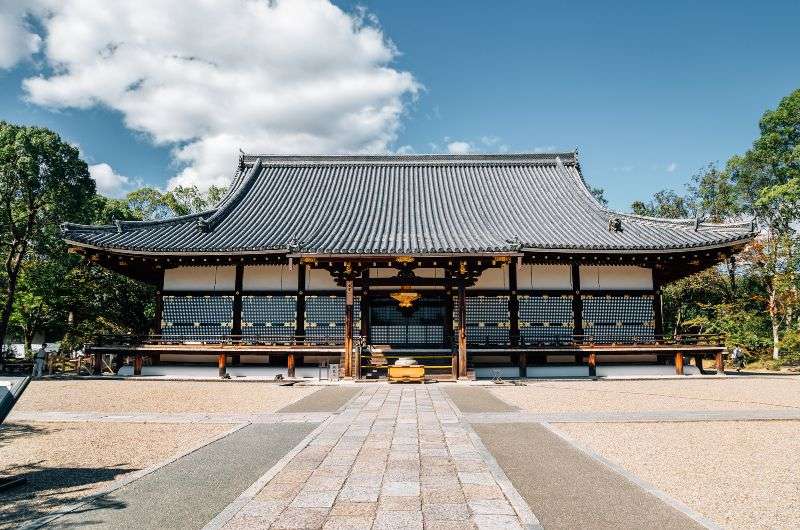
Ninna-ji
Time spent at this stop: 1.5 hours total, slightly more if you’re there for the cherry trees at Ninna-ji
Now obviously, you could spend a whole day in Arashiyama, trying to see all of its temples and each and every bamboo tree grove (yes, there are more, like at Adashino Nenbutsuji), but unless you’re a die-hard temple-o-phile, you need to pace yourself so you don’t burn out.
So, after Jōjakkōji, I’d wave farewell to Arashiyama and drive 15 minutes to Ninna-ji and then its neighbor, Ryōan-ji, both UNESCO World Heritage Sites. Realistically, you can visit Arashiyama proper in just a half day, but I think it makes sense to add these next temples and call it a full day trip.
Getting to Ninna-ji and Ryōan-ji
Getting to these next spots is going to be way easier if you have your own car, which is why I had my own car. It saves you so much time and annoyances like scheduling your sightseeing around train times and being in tight quarters with other humans.
But if you don’t have a car, there is a train line that runs from Arashiyama called the Keifuku Kitano Line. It starts at the train station close to Arashiyama’s Tenryu-ji and stops just a few minutes from Ninna-ji’s Niomon Gate.
Then again, without a car, getting back to your hotel in Kyoto (or wherever you’re heading back to) will be an epic pain. Speaking of hotels, I’m partial to KAYA Kyoto Nijo Castle in Kyoto because sleeping in those rooms was just like being in the tatami rooms of Ryōan-ji’s Hojo!
Anyway, let’s talk about what you’re going to see on this stop in the itinerary and worry about getting to your hotel later:
Ninna-ji was founded in 888 by the reigning emperor, and a member of the imperial family always served as head priest there, which is probably why the temple grounds are so grand. It’s a big place with gardens that are very well kept, as expected. My favorite part is the sand gardens—they’re just perfect and minimalist, and I can appreciate the work that goes into keeping them that way.
You enter through the impressive Niomon Gate that stands rather awkwardly centimeters away from the road, complete with traffic lights. But you get used to things being out of place like this in Japan. Not surprisingly, the most impressive building inside the complex is the place where the head priest used to hang out, called Goten. It’s built like an imperial palace.
Good news for all of you traveling to Japan in mid-April, just missing the cherry blossoms just about everywhere else, you may be in luck at Ninna-ji—it has a grove of late-blooming cherry trees. Around mid-April is when they’re the prettiest, so if you get to Ninna-ji and there’s a long line right after Nionam Gate, it’s because people are queuing to get into the cherry tree garden.
- Tickets to Ninna-ji: JPY 800 to Goten, JPY 500 for the cherry blossom garden, free everywhere else
Next, get ready to get your shoes (and maybe even socks) knocked off at the temple next door to Ninna-ji, Ryōan-ji. It’s because Ryōan-ji is famous for its rock garden, which is just a sand garden with rocks plopped onto it. This one is apparently the finest example of dry landscape gardening in Japan! Given that title, you’d think the thing is bigger than it actually is, but no, it’s small.
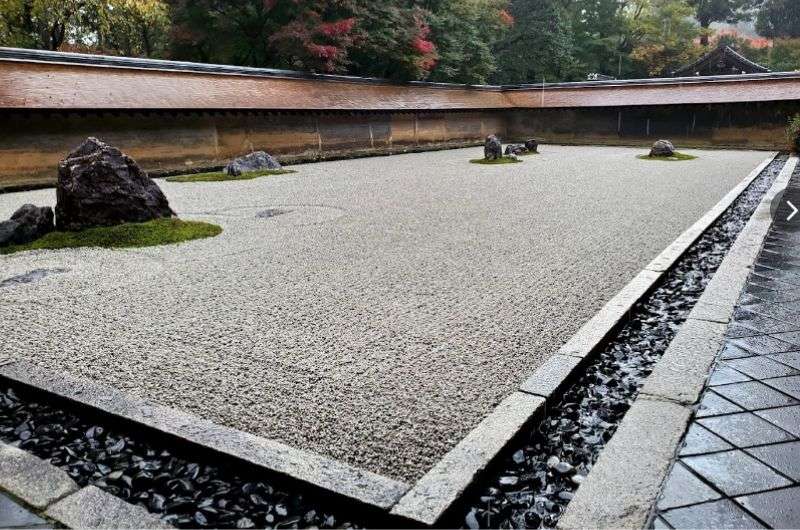
Ryōan-ji’s famous rock garden
Note that to find the rock garden, you need to go inside of the Hojo (the head priest’s former residence) and not wander around like a bunch of headless chickens, thinking the famous rock garden has disappeared or that you just can’t seem to find it.
This is where my clever joke about the shoes and socks comes in—since you need to enter a building to go through and get to the garden (which is outside), you need to leave your shoes at the door. Whether or not your socks will be knocked off is up to you and your tolerance for Buddhist zen symbolism.
Want a challenge? They say you can’t see all of the 15 rocks in the garden at once from any one point of the observation area.
But don’t just go running into the garden and take a moment to notice the tatami rooms and paintings on the sliding doors inside the priest’s house. When you’re coming in through the main entrance, look around—you’re in the temple’s kitchen!
The rest of the ground at Ryōan-ji is also nice, if you’re up for another pretty nature walk. I can imagine it packs more of a punch in the fall with all the colorful trees. We got, once again, just green.
- Tickets to Ryōan-ji: JPY 500
Arashiyama Itinerary, stop 7: Kinkakuji
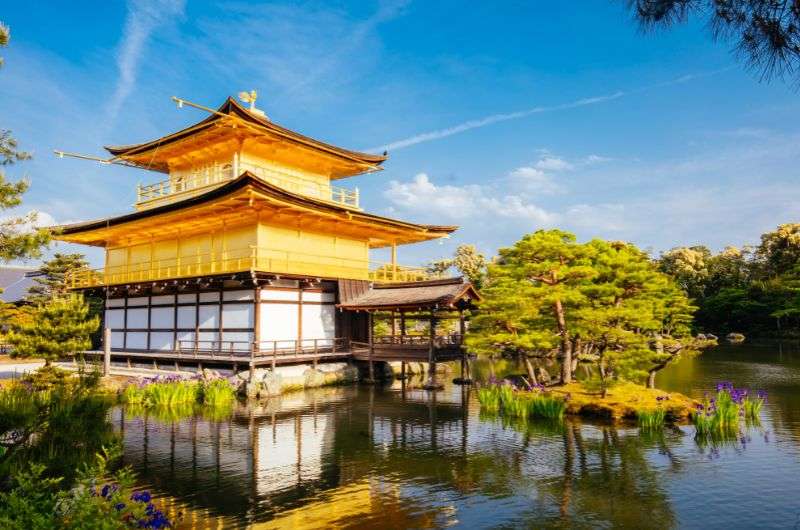
Kinkakuji temple
Time spent at this stop: 1.5 hours
Last but not least, drive or walk from Ryōan-ji to Kinkakuji. Obviously, I’m driving, but if you are using the train, you'd better count on doing a lot of walking! If you’re starting to feel over-tempered, just bite the bullet for a little while longer; Kinkakuji is worth it.
Kinkakuji is one of the 3 most important buildings in Japan (Nikko’s Toshogu Shrine and Tōdai-ji in Nara are the others), so be ready to be impressed. I was, and you know that’s not an easy feat!
There are two things that make a Kinkakuji special: parking right at the entrance, and trash cans! Just kidding, that’s not the main thing you’ll love, but I swear that the trash cans made my day.
Kinkakuji was a shogun’s retirement villa, and I can say he set himself up pretty well: picture a golden pavilion standing on a lake surrounded by luscious nature. It has 3 floors, each built in a different architectural style: the 1st floor is built in the Shinden style of palaces during the Heian period, the 2nd floor is gives samurai home vibes in Bukke style, and the 3rd floor is that of Chinese Zen style, with gold inside and out and has a golden Pheonix on top.
Tip: The shogun’s son built his own retirement villa modeled after his dad’s Golden Pavilion (Kinkakuji). It’s called the Silver Pavilion, aka Gingakuji, and I’ve written about it in my Kyoto itinerary. Maybe you’ll have better luck trying to visit it than I did.
You’ll need to be content with getting a good view of the Golden Pavilion from across the lake, because entrance is forbidden. There’s a designated walking direction, which helps with crowd control and makes the sea of people flow along nicely.
Not nicely enough though—I was fed up with western tourists at Kinkakuji—they butt into shots like they own the place. Japanese visitors, on the other hand, manage to get their own shots and give everyone some breathing room, so it’s proven that it can be done. Learn, losers!
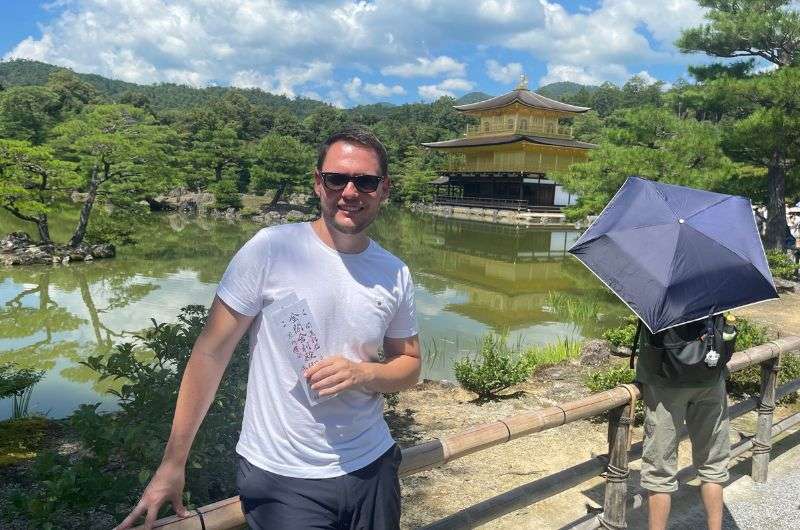
And that’s the last one from me. See you again soon!
After you push all the annoying tourists out of your photos, you continue on through Kinkakuji’s gardens and a teahouse where you can rest a bit under the red maple trees. Being such a small place means you only need an hour or so to see it at a leisurely pace.
- Tickets: JPY 500
Once you’re done at Kinkakuji, I think it’s safe to say your Arashiyama day trip from Kyoto (or Osaka) has come to an end. If you came here by public transportation, good luck! Getting back to your hotel in Kyoto will me more effort than I’d be willing to put in.
If you drove, congratulations, you’ll have enough energy for a great dinner tonight! May I suggest the utterly strange Teppan Tavern Tenamonya experience? You need to make reservations well in advance unless you want to be one of the many people who cry at the locked entrance door. Like for real, that’s what happens and the reason why they lock their guests inside—the ones that made reservations up front, that is!
Where to next?
You could spend a day in precious Nara (who could resist bowing to deer and more temples!) or continue on in Kyoto or Osaka (the perfect blend of old and new with way more to see and do than in, say, Tokyo). Oh, the possibilities!
Let's finish up with 6 FAQs for your Arashiyama 1-day trip:
FAQs
How to get to Arashiyama Station from Kyoto Station?
Arashiyama is part of Kyoto, so you can expect the trip out there from the city center to take no more than 25 minutes by car and 16 minutes by train when traveling from Kyoto Station (the central station in Kyoto) to Saga-Arashiyama Station on the JR Sagano Line. I personally vote for the car, because some of the top spots to see in and around Arashiyama are spaced out far away from each other. I’d use public transportation only if I had no other choice. We never met any serious traffic in Kyoto, so having a car handy is certainly more convenient and faster.
How long does it take to walk through the Arashiyama bamboo walk?
The Arashiyama bamboo walk is just 500 m (0.3 mi) long. There’s one path that you can’t leave, and it gets very crowded. Depending on how long you take trying to get your photos at just the right angle, expect to be done in 20–45 minutes. You can spend longer trying to find other bamboo trees in Arashiyama, like at Jōjakkōji or Adashino Nenbutsuji.
Is Arashiyama walkable?
The main sites in Arashiyama are easily walkable. The bamboo forest trail is just 550 m/0.3 miles from the JR train station. Still, you’ll need to be able to walk at least 5 km/3.5 miles just to see the top things to do in Arashiyama that are close to the bamboo forest. Then there are the further-out spots like the temples near Kinkakuji, and for that, you’ll need a car or train/bus.
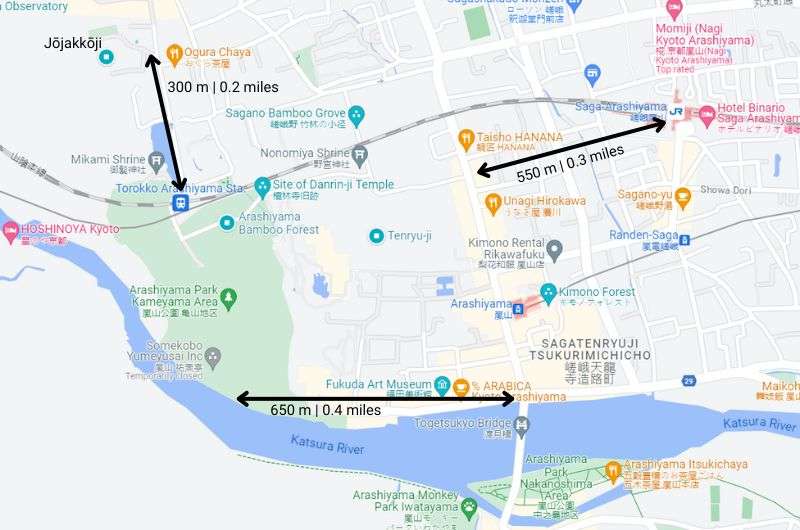
Arashiyama’s top things to do are mostly in a smallish, easily walkable area. But once you include further-out temples like Ninna-ji, Ryōan-ji, and Kinkakuji, you’ll need a set of wheels for sure.
What is the best time to go to Arashiyama?
Visit Arashiyama in the fall to see the hills and temple gardens full of gorgeous colors. Or, spring is the obvious choice for cherry blossom lovers. We went to Arashiyama in the middle of summer, and it was hot—I put a lot of hope into the bamboo trees, hoping for a respite from the heat, but nope. While they do block the sun's light, they do nothing for lowering the temperature!
This post contains affiliate links. I earn a small commission if you make bookings through my links, at no additional cost to you. Thank you for your support!
Arashiyama Itinerary, stop 1: Arashiyama Bamboo Forest
Arashiyama Itinerary, stop 2: Sagano Romantic Train
Arashiyama Itinerary, stop 3: Tenryuji
Arashiyama Itinerary, stop 4: River walk and Arashiyama Park
Arashiyama Itinerary, stop 5: Jōjakkōji
Arashiyama Itinerary, stop 6: Ninna-ji and Ryōan-ji
Arashiyama Itinerary, stop 7: Kinkakuji
How to get to Arashiyama Station from Kyoto Station?
How long does it take to walk through the Arashiyama bamboo walk?



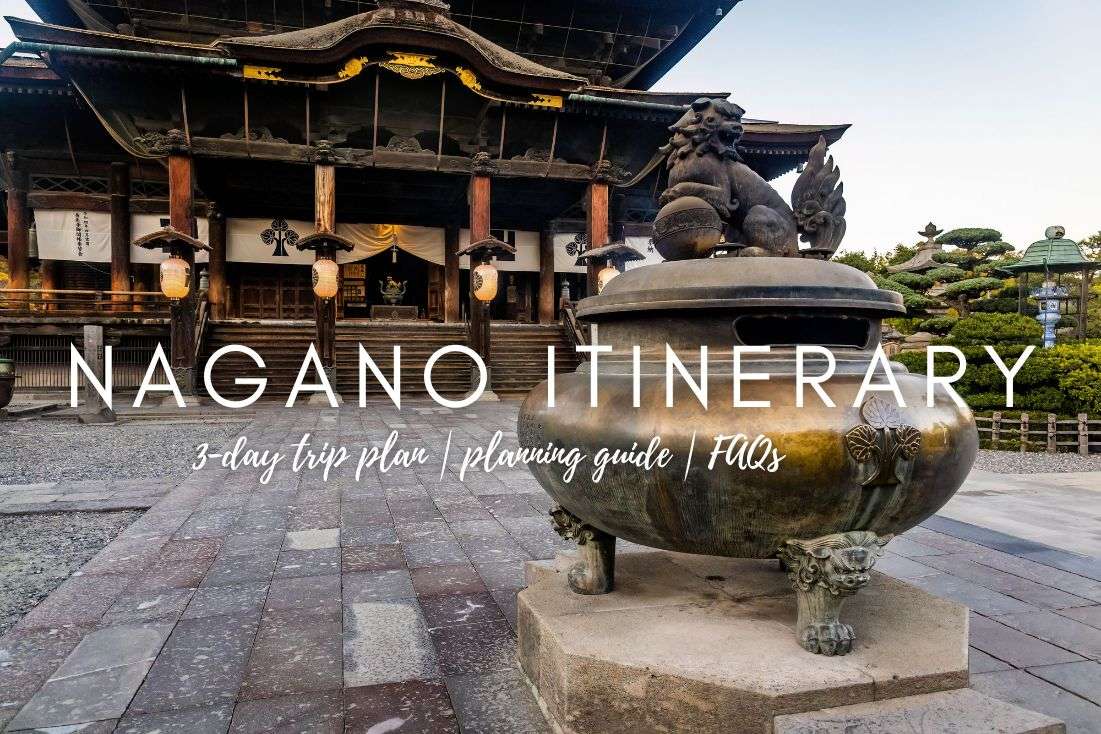
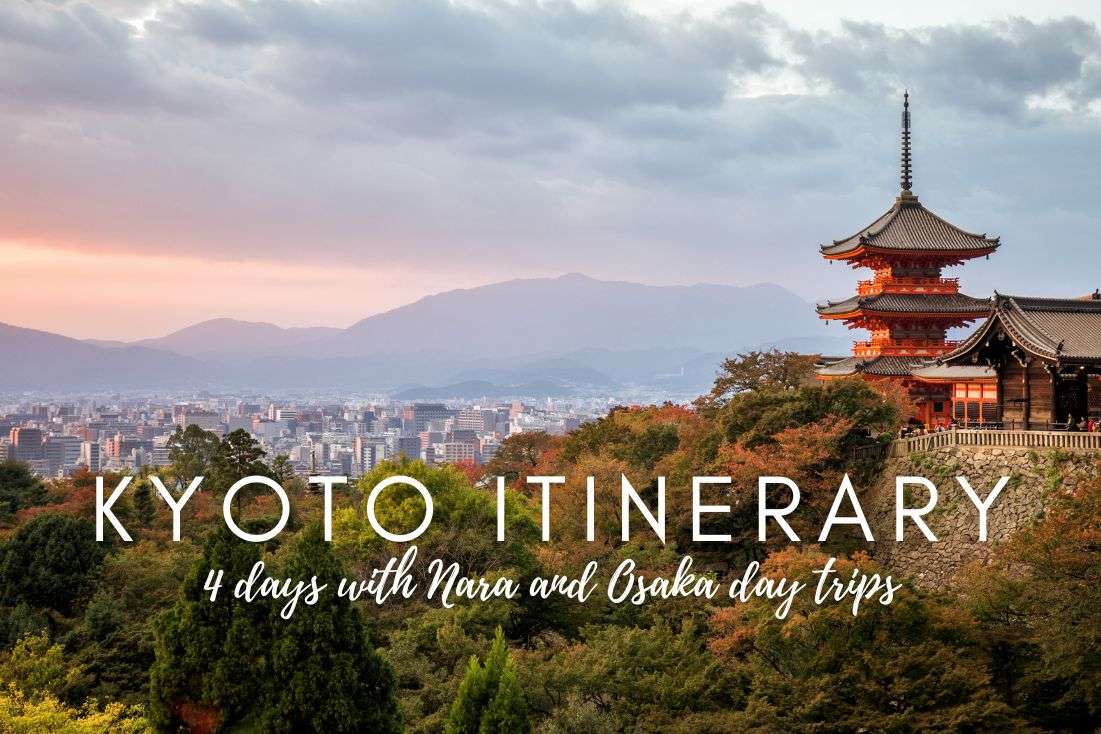





Comments | Thoughts? Give us a shout!